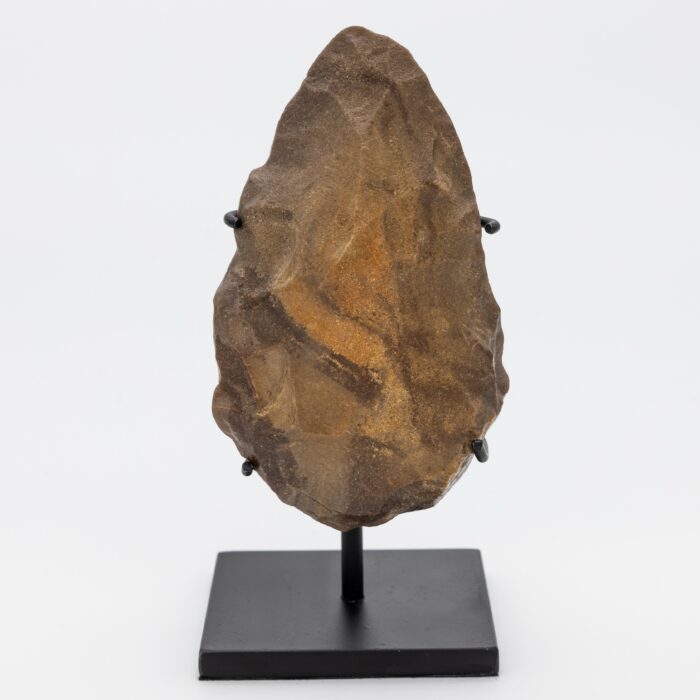From hunted to being hunters
It was not until Homo erectus that members of our species went from being hunted to being hunters. They emerged about 1.9 million years ago and populated our world until about 100,000 years ago.1 That is not so long in the past.
We regard them as early humans. And no other kind of human coexisted with other kinds of humans as long as they did. Some left Africa and migrated to Europe and Asia. Over time, they developed more and more skills and gained new knowledge. Their anatomy in the throat provides hints of more advanced abilities for producing speech.2
Mastering fire
And have you ever heard of Prometheus? He is a figure from ancient Greek mythology. It is said that he stole the fire from Zeus, the supreme god of the ancient Greeks, to bring it to mankind.

Zeus was angry about it. But mastering fire helped the humans incredibly in their further development. With fire, they could prepare food in a completely different way and during cold nights it stayed nice and warm around the fireplace.
Do you wonder why I am telling this old Greek story here? Well, Homo erectus left us the oldest, currently documented fireplaces that we know of today. These fires burned 1 million years ago.3 Homo erectus humans were the real Prometheus! Zeus, however, was far from having come into the human mind back then. 😉
Bifaces / hand axes
Our ancestors also produced double-edged stone knives, so-called bifaces or hand axes.4 For me, these are the oldest examples of real stonemasonry.

This one was found in the south of what is now Libya, a little to the east, in Africa, the cradle of mankind. The beautiful desert patina (the mineral glossy layer on the surface) and the workmanship tell us that it was used between 250 and 600 thousand years ago.5
Did a hungry person use it to split bones to get the delicious marrow? Was it used to dig in the earth? Or did it cut animal skin? Evidence of working acacia wood was also discovered on some Homo erectus bifaces.6
In any case, it’s a wonderful glimpse into the past – and what a feeling when you hold it in your hand: 250 to 600 thousand years old stone art! Unfortunately, a more precise classification of its age is not possible, as it was found in an area and at a time when the evaluation of archaeological sites was apparently still in its infancy. So perhaps this biface was even used by an early member of our own kind of humans?
The human family tree
Because for nearly 300 thousand years, we too have been walking around on the surface of the earth, we, Homo sapiens.7 I know that this is a difficult, unfamiliar thought for us. But once many other kinds of humans existed alongside us, with whom we shared the earth, at the same time. Just as there are, for example, many different kinds of dogs today.8
The human family tree is not a straight line, but rather a long river with branches and new side arms and tributaries, some of which even find together again. The fact that we are the only kind of our species today is indeed an evolutionary rarity.9
Continue with Homo florensis, Neanderthals & Homo denisova…
Footnotes / further reading
- Johanson, D., Edgar, B.: Lucy und ihre Kinder. Munich: Elsevier, 2006, p. 201-207.
- Werde Teil der Menschenfamilie. Mettmann: Neanderthal Museum, 2023, p. 88.
- Berna, F., Goldberg, P, et al.: Microstratigraphic evidence of in situ fire in the Acheulean strata of Wonderwerk Cave, Northern Cape province, South Africa. In: PNAS Vol. 109, No. 20 (February 24, 2012). URL: https://www.pnas.org/doi/full/10.1073/pnas.1117620109. Retrieved May 23, 2023.
- Junker, T.: Die Evolution des Menschen. Munich: C. H. Beck, 2021, p. 20, p. 38, p. 98-100, p. 105/106; Johanson, D., Edgar, B.: Lucy und ihre Kinder. Munich: Elsevier, 2006, p. 40, p. 270/271.
- According to expert evaluation (last v. d. Dries, May 12, 2023).
- Wong, K.: Early Humans Had Woodworking Technology In: Scientific American (April 18, 2001). URL: https://www.scientificamerican.com/article/early-humans-had-woodwork/. Retrieved May 21, 2023; Orgeldinger, M.: Die ältesten Jagdwaffen der Menschheit. In: Tagesspiegel (December 17, 2007) URL: https://www.tagesspiegel.de/wissen/die-altesten-jagdwaffen-der-menschheit-1586908.html. Retrieved May 23, 2023.
- Junker, T.: Die Evolution des Menschen. Munich: C. H. Beck, 2021, p. 24.
- Roberts, A., et al.: Evolution. The Human Story. London: DK Dorling Kindersley, 2023, p. 58-61; Harari, Y. N.: Sapiens. A Brief History of Humankind. London: Vintage Penguin Random House, 2015, p. 4/5.
- Werde Teil der Menschenfamilie. Mettmann: Neanderthal Museum, 2023, p. 23.